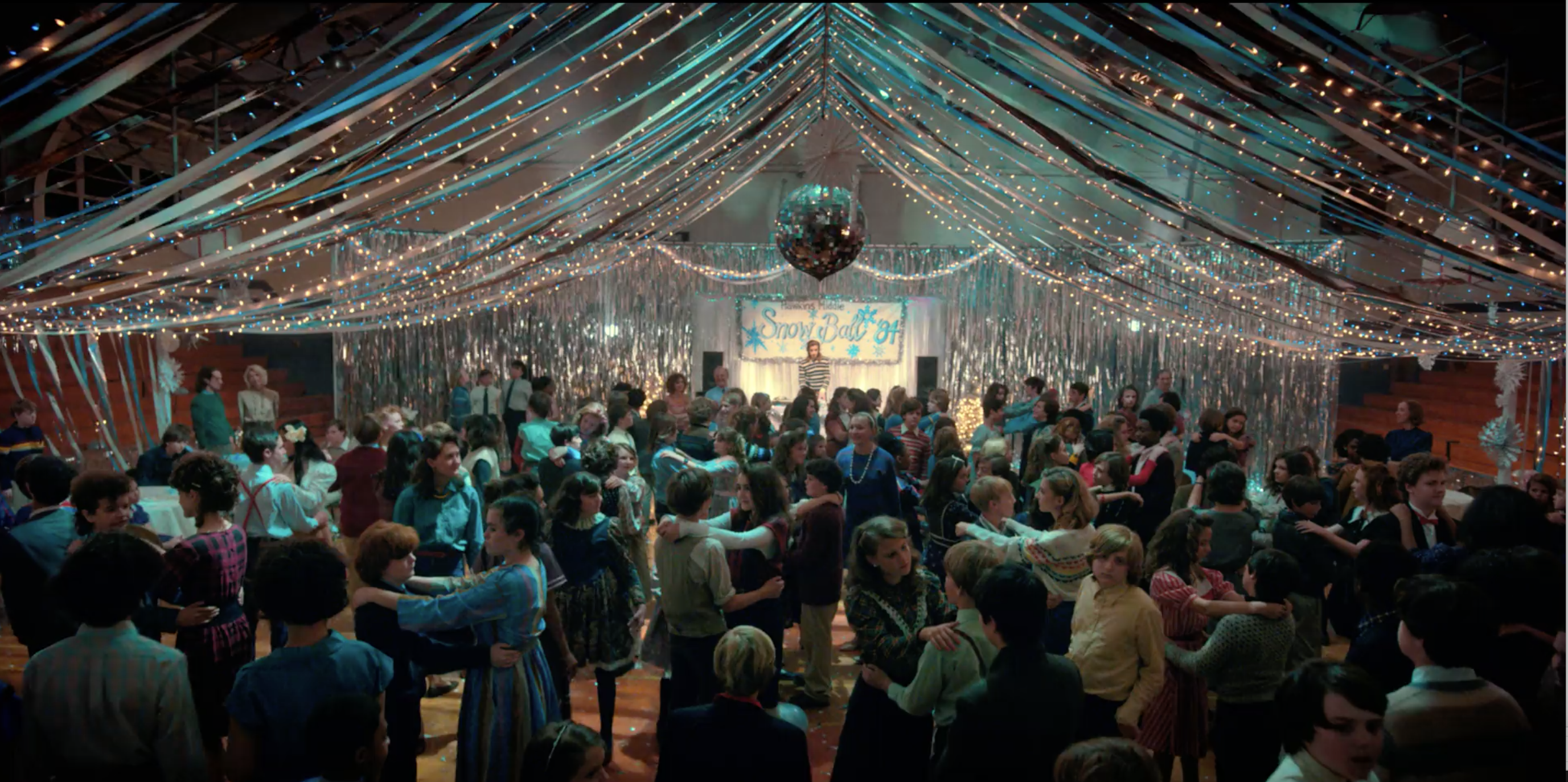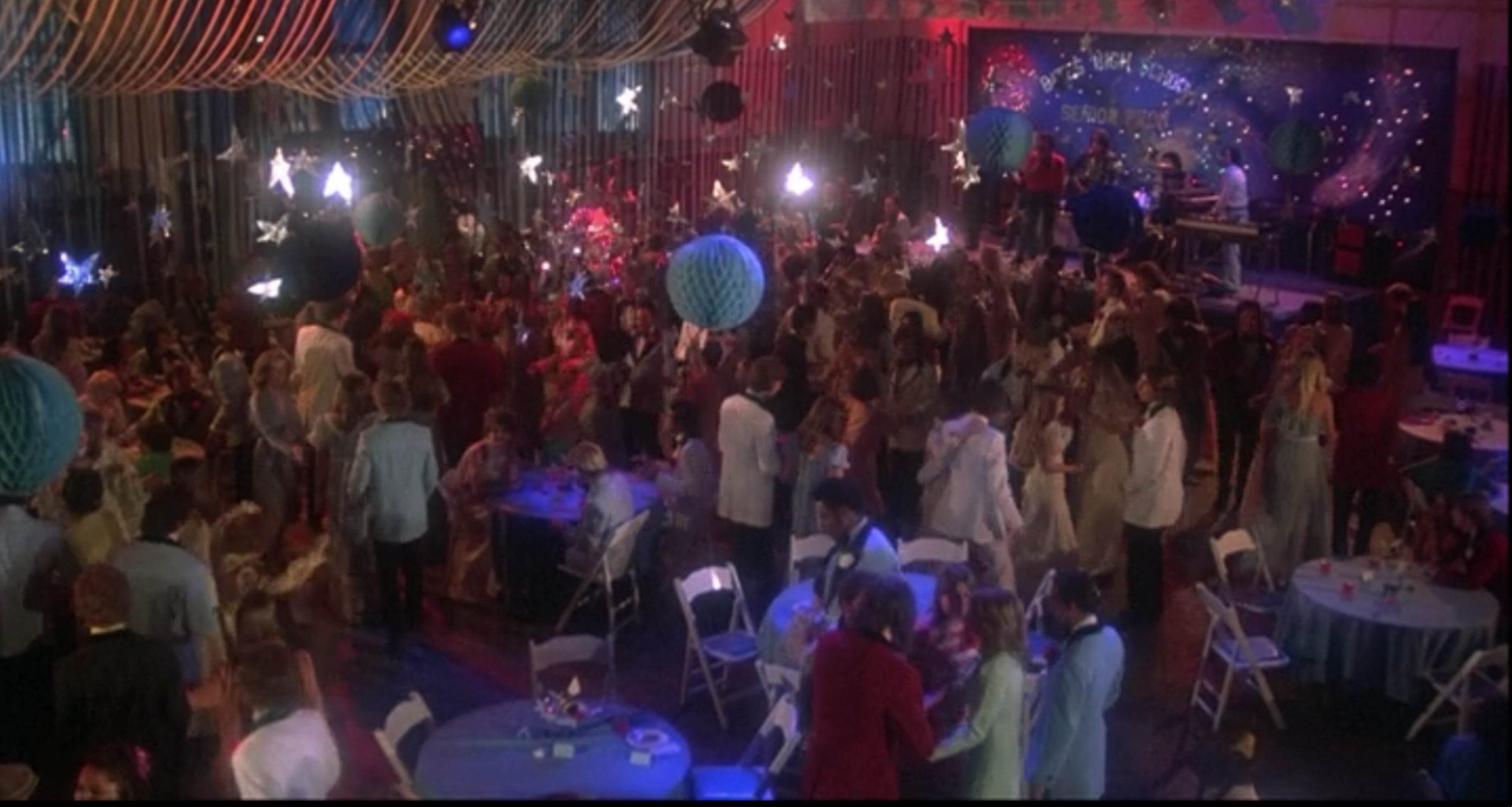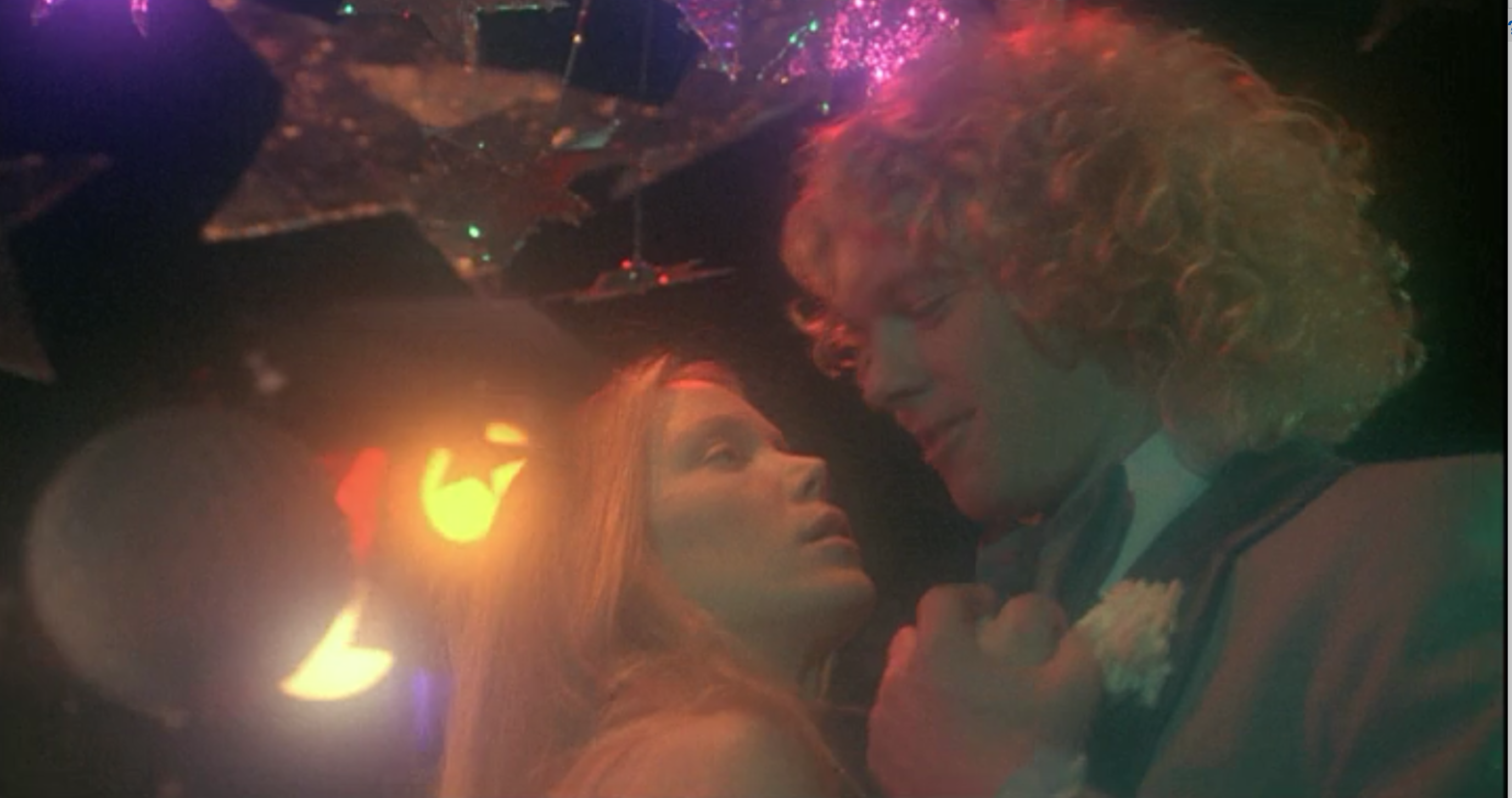Stranger Things and Nostalgia Now
The second season of Stranger Things concludes with a junior high dance, Snow Ball '84. Barely emerged from recent horrors, the kids discover the rituals of straight adolescence by awkwardly slow dancing, paired off in neat heterosexual couples, to pop hits like Pat Benatar's "Love is a Battlefield" and the Police's "Every Breath You Take." The queer energies of the show dissipate as a feminized Eleven shares a first kiss with Mike; Nancy offers the rejected Dustin a sympathy dance and assures him, "Girls this age are dumb. Give them a few years, and they'll wise up. You're gonna drive them nuts"; and Lucas gets the courage to ask Max to dance, as she teasingly calls him "stalker." The ending to this season unites nostalgia, compulsory heterosexuality, and closure, and suggests, as Robin Wood argues in his pivotal essay "An Introduction to the American Horror Film," that the taming of monsters comes with a return to normativity.1 But the middle-school dance scene's overbearingly straight nostalgia clashes with the in-the-know recall of the horror film viewer, triggered by the scene's references to Brian De Palma's Carrie (1976). The prom scene from this 1970s horror film lurks beneath the eighties glitz of the Snow Ball, exposing its nostalgia as a flimsy masquerade.2
The dance presents a counterpart to the conclusion of the first season, which immerses the viewer in another category of normative nostalgia: the Christmas family dinner, this time with a single mom. Joyce scrambles to set the table and complains that her mashed potatoes are too runny while her sons, Will and Jonathan, try to reassure her that everything is perfect. Yet the viewer is soon keyed in to the fact that this reunion is not perfect, that Will is working hard to conceal he has been profoundly altered by his experience in the Upside Down. He excuses himself from the table and goes into the bathroom, where he retches a slimy creature into the sink. Upon his return, he reassures Joyce he is fine and resumes telling her about his game of Dungeons and Dragons, while the camera pulls back to frame the warm domestic scene against the softly falling snow outside and the synth soundtrack pulses and gives way to the series title. Clearly, there are still stranger things in store for Will and his family.
The audience shares Will's dark secret — that his body has internalized the abjection of the Upside Down. This revelation differentiates this scene from the straight nostalgia at the end of the second season. In the dance scene, too, the viewer learns that disruptive things continue to lurk, but this time in a way that separates those things from the awkward dancing on display in the Hawkins Middle School gym. Once the nascent heterosexual experiences of the main characters have been established, a crane shot pulls back from the dancers and a quick cut takes the viewer outside of the school. Only then do things become weird. The frame rotates, tilting the school exterior ninety degrees, and we find ourselves on the other side of the pavement where we see an uncanny double of Hawkins Middle School with a Demogorgon looming over it. In contrast to the ending of the first season, this one is protective of the kids' normalcy, establishing physical barriers — the school walls and the pavement — between their sexual discovery and the monsters out to get them.
This shift from internalized abjection to external protection is especially significant for Will and Eleven, who are the primary loci of queerness in the series. Stranger Things plays with queerness as something tangible yet invisible,3 as witnessed in the series' fascination with preadolescent homosocial bonding and with the manufactured facades of masculinity, particularly in the characters of Steve Harrington and Billy Hargrove, both of whom have really good hair. In an essay for the Advocate, Daniel Reynolds argues that "homophobia is the real monster" of the show, as the main characters' outsider status is identified by bullies and other guardians of the normative as gay; when Will disappears, for instance, one kid remarks, "What's there to be sad about anyway? Will's in fairyland now, right? Flying around with all the other little fairies, all happy and gay." Reynolds goes on to describe Eleven as a "queer avenging angel," whose gender nonconformity leads her to be "repeatedly mistaken for a boy."4
While the end of the first season sustains the characters' queer difference by drawing on the trope of the closet — Will conceals his secret identity in the bathroom, Eleven hides out in the woods — the conclusion to the second season celebrates their initiation into sexual and gender conformity. After a brief hesitation, interrupted by a tap from Mike, Will accepts a girl's offer to dance and joins the swaying group of male/female couples. Strikingly, Eleven enters in a pretty dress and hair and makeup, and bashfully casts down her eyes at Mike's comment, "You look beautiful." They hold hands, he coaches her through some dance steps, and they kiss. The scene cuts from their close-up to the crane shot of the gym full of couples, surrounded on the margins of the space by boys and girls swaying to the music in groups rather than pairs. Beyond these outsiders is the outside of the school and, a little farther still, the Upside Down.

Part of what makes this ending memorable is its conflation of heterosexual bonding with a climax of eighties nostalgia. For those viewers who experienced and survived the compulsory heterosexuality of the middle-school dance, the songs, decorations, and outfits resonate with a stifling familiarity. For those whose adolescence occurred in a different historical moment or geographical space, the scene produces what Alison Landsberg terms a "prosthetic memory" of the event.5 The Snow Ball conflates the warmth of rediscovering a long-lost (or never extant) historical moment with a memory of heterosexual awakening that might also be fictional. Reliving the eighties entails accepting and internalizing the memory of straight adolescence as our own. With this last dance, the series seems to close off the possibility of queer temporality and, in Jack Halberstam's words, its "opposition to the institutions of family, heterosexuality, and reproduction." 6
And yet, the series does give the viewer the opportunity to spit out these straight memories, as Will does the slimy monster in the bathroom. It inserts a moment of cinematic intertextuality in the dance sequence that pushes against its straight eighties nostalgia. The scene invokes the iconic and distinctly non-nostalgic prom scene from Brian De Palma's Carrie, which subtly counteracts the forced identifications of Snow Ball '84. Both show characters grooming in front of mirrors in preparation for the big event, deploy overhead establishing shots of the glittery gym and its painfully invested teenagers, and rotate the camera around the dancing couples.

At the center of both sequences is a "pity" dance that serves as an initiation into heterosexual rituals: Tommy's girlfriend, Sue, forces him to ask Carrie to the prom to compensate for her own prior bullying of the outcast girl; in Stranger Things, Nancy invites Dustin to dance after he has been rejected by several girls his age. In both cases, the pitying character teaches the pitied one to dance through instructions to "just listen to the music." With these allusions, the audience is invited to recognize the oppressiveness of dominant nostalgia narratives and turn to the cinematic memory of a horror film in which heterosexuality is an undeniable source of terror.
De Palma presents prom as a site of fantasy and grotesqueness, in which acceptable gender and sexual roles are forcibly, and violently, imposed. The culmination is the dumping of pig's blood on Carrie and Tommy's heads when they stand as prom queen and king, but the violence of normativity is evident earlier in the grooming and normalization rituals the characters undertake both before and during the prom. Miss Collins, Carrie's gym teacher, dreamily recounts the pain of her own prom, when she wore stiletto heels and spent the night unable to dance because her feet were covered in painful blisters. "It was magic," she says, and assures Carrie that she, too, will "never forget" her prom. In both proms, nostalgia is grounded in pain and horror that needs to be rewritten as positive. Making an event worthy of nostalgia involves affective labor that rivals the hard work of shaping oneself into gender and sexual conformity. It requires policing appearances or behaviors that go against the norm. Tommy interrupts Miss Collins's and Carrie's intense conversation about prom nostalgia and their ensuing hug by playfully asking the gym teacher, "Hey, what's going on here? What are you doing with my date?" and informing Carrie, "Don't let me catch you hugging any guys like that." Although (or perhaps because) they emerge as jokes, heteronormative threats against queer identities dictate what desires are acceptable.
The labor required for heterosexual norms to implant themselves is further apparent when Tommy and Carrie share their only dance, during which they rehearse prescribed gender roles.
Carrie: Why am I here?
Tommy: Because it's the prom.
Carrie: Why am I here with you?
Tommy: Because I asked you.
Carrie: Why'd you ask me?
Tommy: Because I wanted to.
Carrie: Why'd you want to?
Tommy: Because you liked my poem. Only I didn't write it; somebody else did.

The last question and answer refer to a moment when Tommy read a poem in class that Carrie vocally admired. That Tommy admits he plagiarized the poem speaks to the lack of originality in such heterosexual rituals, that they always emerge from a script. The film signals that this is not sweet, playful banter but something far more sinister — an indoctrination into oppressive gender hierarchies — as the camera spins disorientedly around their dancing bodies.
The compulsory identification exhorted by the Snow Ball clashes with these references to Carrie. This is one of the only moments in Stranger Things when intertextuality and nostalgia come into conflict. The series' references to eighties movies such as E.T. (Steven Spielberg, 1982) and The Goonies (Richard Donner, 1985), and even to Poltergeist (Tobe Hooper, 1982) and A Nightmare on Elm Street (Wes Craven, 1984), are imbued with a wistfulness for the era and its iconic tropes.7 In contrast, the references to Carrie, a film from the late seventies, situate nostalgia and intertextuality in opposition, until the latter dismantles the former's mythmaking strategies. Though Eleven's prettification and her subsequent first kiss with Mike might implant memories of heterosexual awakening, celebration of compulsory heterosexuality is undermined by references to Carrie's indoctrination into mainstream teenage life and its terrifying consequences. [Figure 4] Parallel readings apply to Dustin's dance with Nancy — which might evoke the dark results of the conflation of pity and trickery in Carrie — and to Will's first dance. His mother anxiously waits outside and tells Hopper with an eyeroll that "Will wanted me to give him some space," which might trigger the viewer's memory of Mrs. White murderously waiting for her daughter to come home from the prom.
Horror spectators are granted X-ray vision in this scene, which forces them to see beyond the heterosexual façade of the Snow Ball. They don't need the camera to take them outside and drag them beneath the school sidewalk to reveal what lies beneath its institutional structure. As such, the Snow Ball scene might be yet more disruptive to normativity than the invocation of the closet in Will's private trip to the bathroom at the end of season one. The references to Carrie provide an alternate perspective on Eleven's masquerade of straightness and Will's initial hesitation to dance with a girl — maybe he really doesn't want to dance with her or any girl, for that matter. A seventies film focused on older teenagers whose development into adulthood is marked by violence and failure, Carrie inserts a queer temporality that disrupts the possibility or desirability of progress into straight adolescence. The excessive nostalgia of the Snow Ball is a masquerade that, at any moment, might be cast aside by the upside-down world of heterosexual horror.
Aviva Briefel is Professor of English and Cinema Studies at Bowdoin College. She is the author of The Deceivers: Art Forgery and Identity in the Nineteenth Century (2006) and The Racial Hand in the Victorian Imagination (2015), and coeditor of Horror after 9/11: World of Fear, Cinema of Terror (2011). She has written extensively on the horror film.
References
- Robin Wood, "An Introduction to the American Horror Film," in Planks of Reason: Essays on the Horror Film, ed. Barry Keith Grant and Christopher Sharrett (Lanham: Scarecrow Press, 2004), 83.[⤒]
- I borrow the idea of masquerade from Mary Ann Doane, who famously uses this concept to describe the revelatory effects of excessive female adornment in the woman's film: "Masquerade...involves a realignment of femininity, the recovery, or more accurately, simulation, of the missing gap or distance." Mary Ann Doane, "Film and the Masquerade: Theorizing the Female Spectator," in Feminist Film Theory: A Reader, ed. Sue Thornham (New York: New York University Press, 1999), 139.[⤒]
- In a discussion of It Follows (David Robert Mitchell, 2014), a horror film that also tests the relationship between horror and nostalgia, David Church writes that "queerness" functions "as a sort of structuring absence within the text, an unnamed but perpetually haunting presence, . . . [which] despite recent political shifts, cannot be fully incorporated into normative socialization." David Church, "Queer Ethics, Urban Spaces, and the Horrors of Monogamy in It Follows," Cinema Journal 57, no. 3 (Spring 2018): 15.[⤒]
- David Reynolds, "Homophobia is the Real Monster in Stranger Things," Advocate, July 26, 2016.[⤒]
- As she writes, "technologies of mass culture and the capitalist economy of which they are a part open up a world of images outside a person's lived experience, creating a portable, fluid, and nonessentialist form of memory." Alison Landsberg, Prosthetic Memory: The Transformation of American Remembrance in the Age of Mass Culture (New York: Columbia University Press, 2004), 18.[⤒]
- J. Halberstam, In a Queer Time and Place: Transgender Bodies, Subcultural Lives (New York: New York University Press, 2005), 1.[⤒]
- For one of several lists of intertextual allusions in the series, see Brian Tallerico, "Every Major Pop-Culture Reference in Stranger Things 2, from A to Z," Vulture, November 2, 2017.[⤒]
